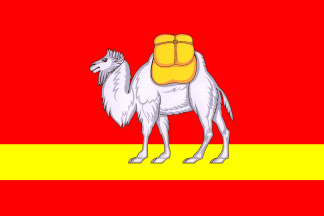
Last modified: 2024-11-23 by rob raeside
Keywords: Ĉelâbinsk | chelyabinsk | simargl | camel |
Links: FOTW homepage |
search |
disclaimer and copyright |
write us |
mirrors
 image by Pascal Gross, 04 February 2002
image by Pascal Gross, 04 February 2002
(Note: You need an Unicode-aware software and font to correctely view the cyrillic text on this page. See here transliteration details).
Both symbols [flag and arms] have been adopted on December 27, 2001 during
a meeting of the deputees of the regional legislative assembly. The flag is
described having a red background with a camel (historical
symbol) and a yellow stripe symbolizing the Ural mountains, their beauty
and the richness of their subsoil.
Pascal Gross, 04 Feb 2002
According to this
article, the regional flag was first hoisted on April 4, 2002.
Pascal Gross, 24 Jun 2002
.gif) image by Pascal Gross, 04 February 2002
image by Pascal Gross, 04 February 2002
A camel (Camelus bactrianus) is shown — clearly not
the chimaera-like simargl reported in 1999.
António Martins, 22 December 2002
The information on Chelyabinsk Region is very poor.
We know only that: In the end of 1999 a coat of arms
was proposed. It consists of flying lion with dog’s head
(named Simargl) and sables as supporters. The only
avaliable laws are about contest (Regulation on contest
and other not-interesting things).
Victor Lomantsov, 14 February 2000
Flag with simargl was not oficially adopted.
It is only a project.
Victor Lomantsov, 23 December 2002
The beast portraited in the Nogai
ethnical flag sure fits the description of this simargl
— and though Daghestan (where the
Nogai dwell) is some 1500 km SW of Chelyabinsk region, there may
be a connection, as both Nogay and Bashkir
(the second largest ethnical group in Chelyabinsk region, after
the Russians) are (western) turkic
(slim connection, shared with eight other
peoples of the Russian Federation, but
who knows…).
António Martins, 26 December 2002